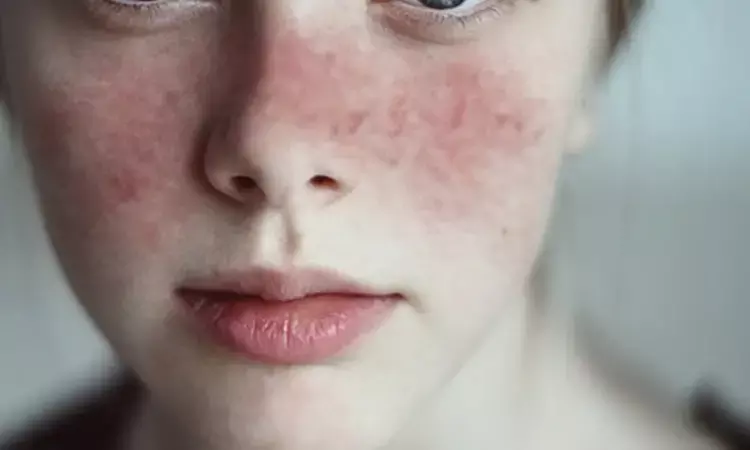- Home
- Medical news & Guidelines
- Anesthesiology
- Cardiology and CTVS
- Critical Care
- Dentistry
- Dermatology
- Diabetes and Endocrinology
- ENT
- Gastroenterology
- Medicine
- Nephrology
- Neurology
- Obstretics-Gynaecology
- Oncology
- Ophthalmology
- Orthopaedics
- Pediatrics-Neonatology
- Psychiatry
- Pulmonology
- Radiology
- Surgery
- Urology
- Laboratory Medicine
- Diet
- Nursing
- Paramedical
- Physiotherapy
- Health news
- Fact Check
- Bone Health Fact Check
- Brain Health Fact Check
- Cancer Related Fact Check
- Child Care Fact Check
- Dental and oral health fact check
- Diabetes and metabolic health fact check
- Diet and Nutrition Fact Check
- Eye and ENT Care Fact Check
- Fitness fact check
- Gut health fact check
- Heart health fact check
- Kidney health fact check
- Medical education fact check
- Men's health fact check
- Respiratory fact check
- Skin and hair care fact check
- Vaccine and Immunization fact check
- Women's health fact check
- AYUSH
- State News
- Andaman and Nicobar Islands
- Andhra Pradesh
- Arunachal Pradesh
- Assam
- Bihar
- Chandigarh
- Chattisgarh
- Dadra and Nagar Haveli
- Daman and Diu
- Delhi
- Goa
- Gujarat
- Haryana
- Himachal Pradesh
- Jammu & Kashmir
- Jharkhand
- Karnataka
- Kerala
- Ladakh
- Lakshadweep
- Madhya Pradesh
- Maharashtra
- Manipur
- Meghalaya
- Mizoram
- Nagaland
- Odisha
- Puducherry
- Punjab
- Rajasthan
- Sikkim
- Tamil Nadu
- Telangana
- Tripura
- Uttar Pradesh
- Uttrakhand
- West Bengal
- Medical Education
- Industry
Belimumab therapy provides better outcome in patients with Cutaneous Lupus Erythematosus

A new study conducted by Rachel Kneeland and team shows that significant belimumab-induced cutaneous clinical responses (44%–55%) and a 50% reduction in flare risk over the course of a year in patients with cutaneous lupus erythematosus (CLE) and systemic lupus erythematosus (SLE), respectively. The findings of this study were presented at American College of Rheumatology Convergence 2022.
With or without SLE, SLE can be very disabling, leave behind substantial scarring, and lead to psychological suffering. One of only four drugs for SLE that the FDA has authorized is belimumab, a monoclonal antibody that prevents B-cell activation. Less is known, however, about belimumab's usage in CLE with or without SLE. Furthermore, it is uncertain when individuals with cutaneous illness will respond to belimumab, which might cause them to stop treatment too soon if there aren't any immediate improvements. Therefore, the goals of this meta-analysis were to investigate: a) the effectiveness of belimumab; b) the time to response following belimumab administration in patients with CLE with or without SLE.
The primary outcome was investigated using a random effects modeling (rma) in R to compare clinical response at 52 weeks between belimumab users and non-users. A reduction in the cutaneous domain from a baseline BILAG A or B score to a BILAG score of B-E was considered a clinical response. The time it took to establish a sustained response in CLE with or without SLE after initiating belimumab was also determined, along with the pooled odds ratio for each successive 4-week observation period. Finally, 52-week pooled probabilities of cutaneous flares in belimumab users compared to non-users were combined. Using I2, heterogeneity was evaluated.
The key findings of this study were:
1. 13 abstracts out of 745 that were manually evaluated were included. The meta-analysis only included six blinded interventional trials comparing belimumab users and non-users for cutaneous response in individuals with SLE or CLE.
2. Belimumab users had 44% greater chances of a clinical response at 52 weeks than non-users.
3. After commencing belimumab, a clinical response was initially detected after 20 weeks, and it continued over the next year, reaching its peak.
4. Users of belimumab had a 49% decreased chance of developing severe cutaneous flares than non-users.
5. There was no heterogeneity and a minimal risk of bias in 70% of interventional trials.
In conclusion, these results indicate belimumab as a beneficial adjunct or alternative therapy for patients with CLE, whether or not they also have SLE. They may also let patient counseling know that it takes around 20 weeks to get a noticeable response. Future research should compare the effectiveness of belimumab across different CLE subtypes.
Reference:
Kneeland R, Montes D, endo J, Shields B, Bartels C, Garg S. Significant Improvement in Cutaneous Lupus Erythematosus with or Without Systemic Lupus Erythematosus with Belimumab Use – a Systematic Review and Meta-Analysis [abstract]. American College of Rheumatology. ACR Convergence 2022. Arthritis Rheumato; 74 (suppl 9). November 12, 2022.
Neuroscience Masters graduate
Jacinthlyn Sylvia, a Neuroscience Master's graduate from Chennai has worked extensively in deciphering the neurobiology of cognition and motor control in aging. She also has spread-out exposure to Neurosurgery from her Bachelor’s. She is currently involved in active Neuro-Oncology research. She is an upcoming neuroscientist with a fiery passion for writing. Her news cover at Medical Dialogues feature recent discoveries and updates from the healthcare and biomedical research fields. She can be reached at editorial@medicaldialogues.in
Dr Kamal Kant Kohli-MBBS, DTCD- a chest specialist with more than 30 years of practice and a flair for writing clinical articles, Dr Kamal Kant Kohli joined Medical Dialogues as a Chief Editor of Medical News. Besides writing articles, as an editor, he proofreads and verifies all the medical content published on Medical Dialogues including those coming from journals, studies,medical conferences,guidelines etc. Email: drkohli@medicaldialogues.in. Contact no. 011-43720751


